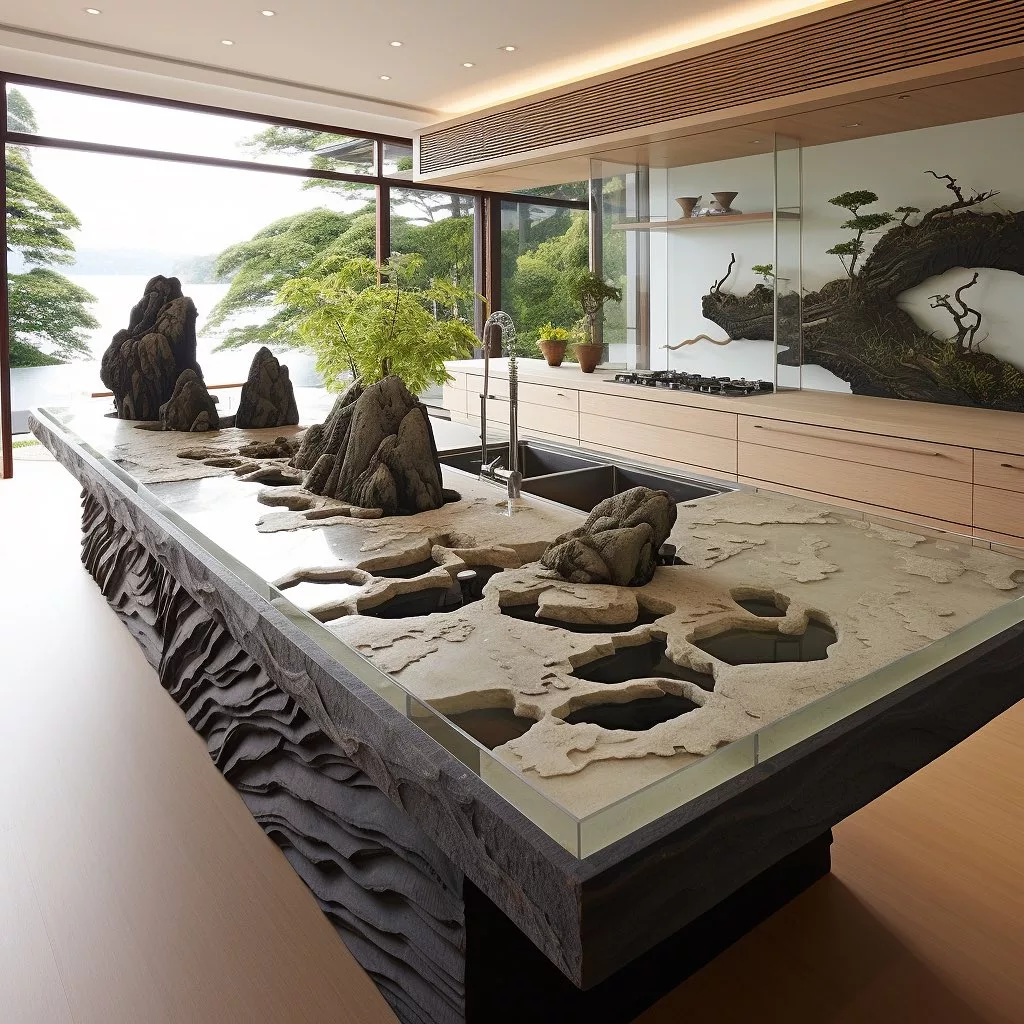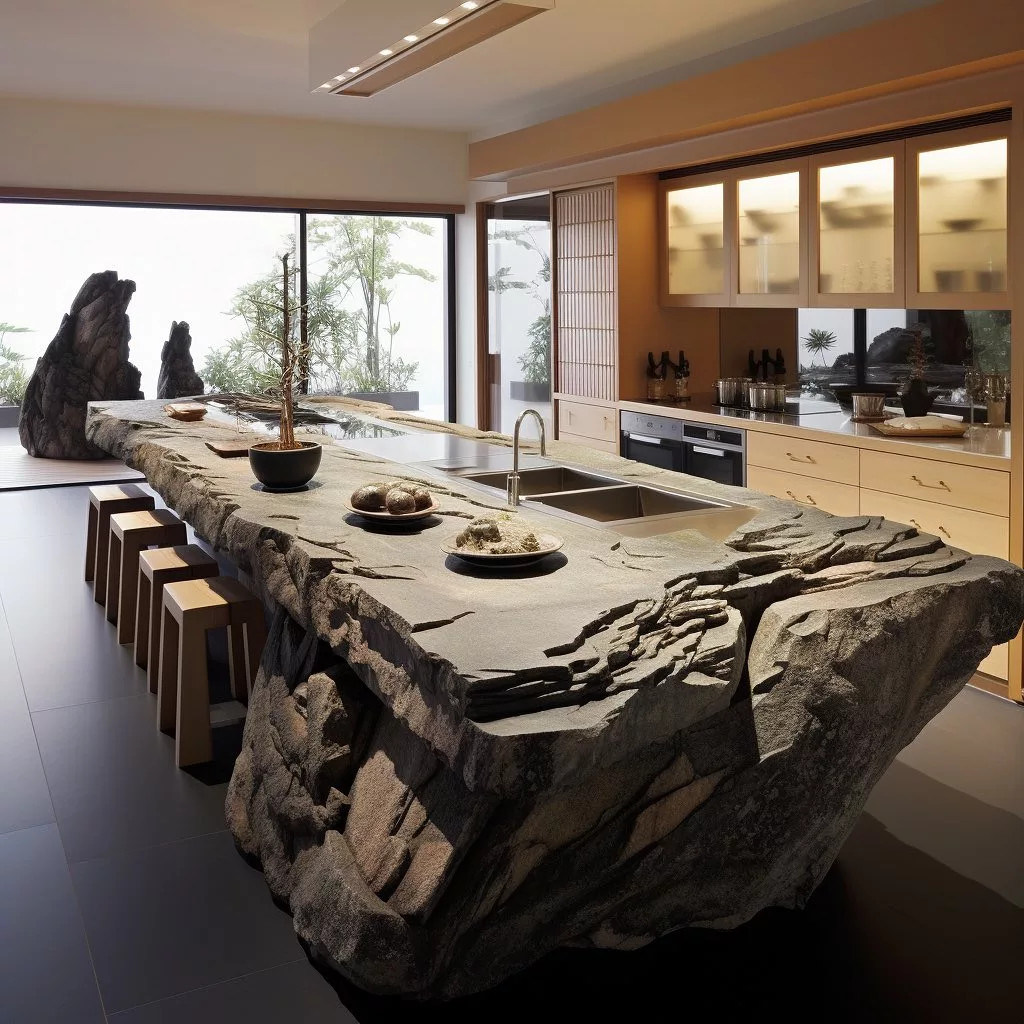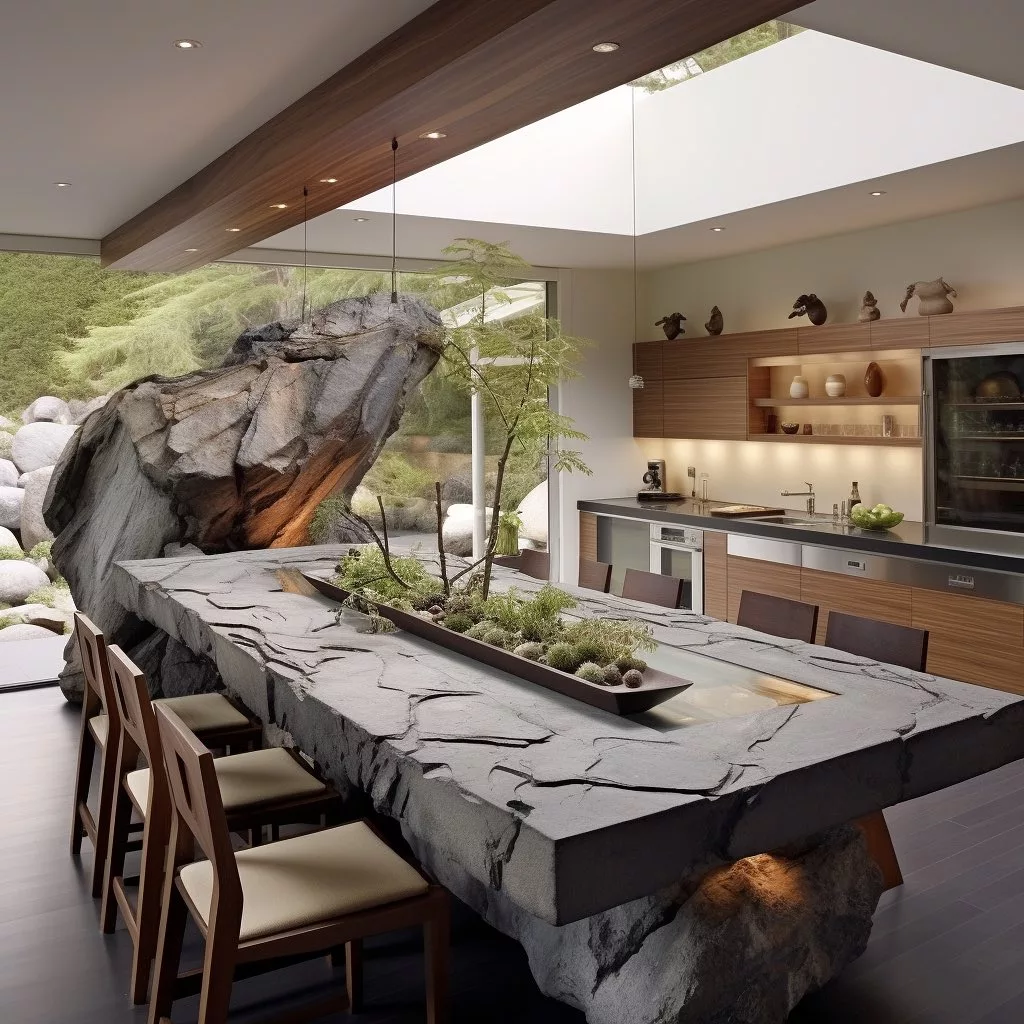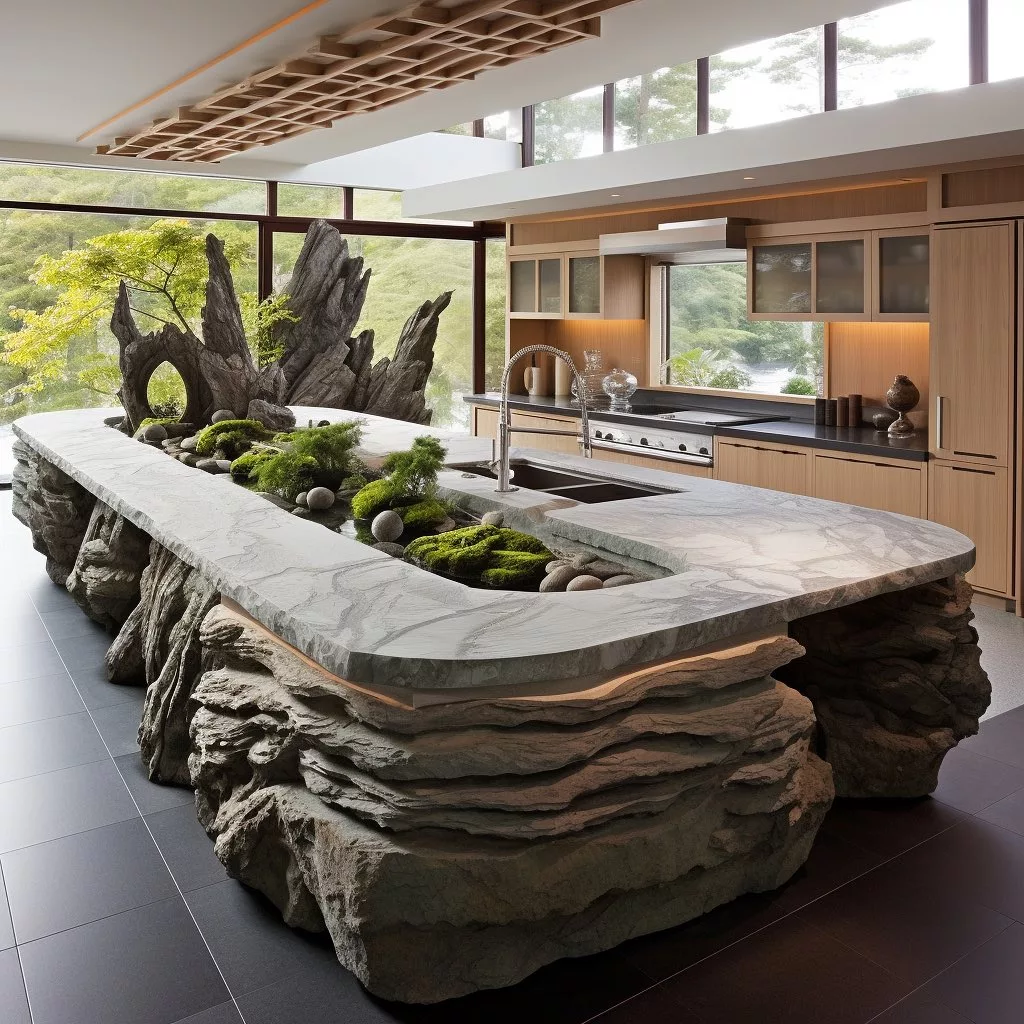Looking to add a unique and natural touch to your outdoor space? Rock garden kitchen islands are the perfect way to bring the beauty of nature into your backyard. These outdoor kitchen islands have become increasingly popular in home design, providing a stunning focal point for both cooking and entertaining.
Constructed with durable stone materials, rock garden kitchen islands not only add visual appeal but also stand up to the elements. The use of stone ensures longevity and creates a rustic charm that fits seamlessly into any outdoor setting. Whether you’re a seasoned DIY enthusiast or new to construction projects, there are various methods and frame systems available to help you create the perfect rock garden kitchen island that suits your skill level and climate.

Embrace the world of outdoor cooking and transform your space with a rock garden kitchen island. Get ready to impress your guests while enjoying the natural beauty that surrounds you.
Contents
- 1 Types of Outdoor Kitchen Stone
- 2 Stone Pattern Options
- 3 How to Build an Outdoor Kitchen with Stone
- 4 Weighing the Pros and Cons of Outdoor Kitchen Stone
- 5 Choosing the Best Stone for Your Grill Island
- 6 The Best Stone for Your Rock Garden Kitchen Island
- 7 Benefits of an Outdoor Kitchen Island
- 8 Stone Outdoor Kitchen Island Designs
- 9 Conclusion
- 10 FAQs
Types of Outdoor Kitchen Stone
Granite, marble, and limestone are the three main types of stone commonly used for outdoor kitchen islands. Each type of stone has its own unique characteristics and appearance, allowing you to choose the one that best suits your personal preferences, budget, and desired aesthetic.
Granite
Granite is a popular choice for outdoor kitchen islands due to its durability and natural beauty. It is a hard, igneous rock that can withstand various weather conditions without deteriorating or losing its charm. Here are some key points about granite:
- Pros:
- Resistant to heat, scratches, and stains.
- Comes in a wide range of colors and patterns.
- Requires minimal maintenance.
- Cons:
- Can be more expensive compared to other types of stone.
- May require sealing to maintain its quality over time.
Marble
Marble is known for its elegance and timeless appeal. It adds a touch of sophistication to any outdoor kitchen island design. However, it’s important to note that marble requires extra care due to its porous nature. Here’s what you need to know about marble:
- Pros:
- Offers a luxurious look with unique veining patterns.
- Provides a cool surface ideal for baking or pastry making.
- Cons:
- Prone to scratching and staining if not properly sealed.
- Requires regular maintenance and sealing.
Limestone
Limestone is a versatile option for outdoor kitchen islands as it comes in various finishes like honed or polished. It’s less dense than granite but still offers durability when properly cared for. Consider these points when considering limestone:
- Pros:
- Has a natural earthy appearance with soft colors.
- Absorbs less heat compared to other stones.
- Cons:
- More susceptible to scratches and stains than granite or marble.
- Requires regular cleaning and sealing.
When choosing the right stone for your outdoor kitchen island, it’s essential to consider factors such as your budget, maintenance requirements, and the overall aesthetic you want to achieve. Granite is an excellent choice if you prioritize durability and a wide range of color options. Marble is perfect for those seeking a luxurious and elegant look but are willing to invest time in maintenance. Limestone offers a natural appeal with softer tones and lower heat absorption.
Remember, each stone has its own pros and cons, so take the time to research and select the one that aligns with your preferences and needs. With proper care and maintenance, your rock garden kitchen island will be a stunning addition to your outdoor space.

Stone Pattern Options
The stone pattern options are crucial in creating a unique and visually appealing outdoor space. Let’s explore some of the different patterns that can be used to enhance the overall look and feel of your kitchen island.
Herringbone
One popular stone pattern option is herringbone, which creates a zigzag effect with interlocking rectangular stones. This pattern adds a touch of elegance and sophistication to your outdoor kitchen island. The alternating arrangement of the stones creates a visually interesting design that catches the eye. It’s a great choice if you want to add a sense of movement and flow to your space.
Basket Weave
Another option is the basket weave pattern, which resembles the weaving technique used in baskets. This pattern involves laying individual stones horizontally and vertically, creating a grid-like appearance. The result is a charming and rustic look that adds character to your rock garden kitchen island. The basket weave pattern works well with various types of stones, from natural field stone to engineered stone panels.
Running Bond
The running bond pattern is commonly seen in brickwork but can also be applied to stone installations. In this pattern, each row of stones is offset by half its length from the row below it. This creates an attractive staggered effect that adds depth and dimension to your outdoor kitchen island. The running bond pattern works particularly well with larger stones or tile backsplash for added visual interest.
Customization and Creativity
The beauty of using different stone patterns for your rock garden kitchen island lies in the ability to customize and get creative with your design. You have the freedom to mix and match patterns or even create your own unique style by combining different elements.
By choosing the right stone pattern for your outdoor kitchen island, you can transform it into an inviting space that reflects your personal style and taste. Whether you prefer an ashlar stone look with clean lines or a more rustic feel with mortar lines, the options are endless.
So, when designing your rock garden kitchen island, take some time to consider the stone pattern that best suits your vision. Whether it’s herringbone, basket weave, running bond, or a custom design, the pattern you choose will contribute to the overall aesthetic appeal of your outdoor space.
How to Build an Outdoor Kitchen with Stone
Building an outdoor kitchen with stone can be a fantastic addition to your backyard, providing a functional and stylish space for cooking and entertaining. However, this project requires careful planning and preparation to ensure successful construction. Here are the steps you need to follow:
Create a Solid Foundation
The first step in building an outdoor kitchen with stone is creating a solid foundation. This involves determining the location of your kitchen and preparing the ground accordingly. You’ll want to choose an area that is level and stable, ensuring that your kitchen is safe and durable.
Install a Frame
Once you have prepared the foundation, it’s time to install a frame for your outdoor kitchen. The frame will provide support for the countertops, appliances, and other components of your kitchen. You can use materials such as wood or metal to construct the frame, making sure it is sturdy enough to withstand the weight of the stone veneer.
Add Stone Veneer
Now comes the fun part – adding the stone veneer! This is what will give your outdoor kitchen its beautiful and natural look. There are various types of stone veneer available, including natural stone or manufactured options that mimic the appearance of real stone. Choose one that suits your style preferences and budget.
When applying the stone veneer, make sure to follow manufacturer instructions carefully. Use mortar or adhesive specifically designed for outdoor use to secure the stones in place. Take your time during this step to ensure proper alignment and spacing between each piece of stone.
Seal the Surface
To protect your outdoor kitchen from weather elements like rain or UV rays, it’s essential to seal the surface of the stone veneer once it has been installed. Applying a high-quality sealer will help prevent staining, cracking, or fading over time.
Before sealing, make sure that all mortar joints are fully cured and dry. Follow the manufacturer’s instructions on how many coats of sealer to apply and how often it should be reapplied. Regular maintenance, such as cleaning and resealing, will help prolong the lifespan of your outdoor kitchen.
Building an outdoor kitchen with stone can be a rewarding project that adds value to your home and enhances your outdoor living space. While it is possible to undertake this project yourself, hiring professionals or following detailed DIY guides can provide additional guidance and ensure successful construction.
Remember, building an outdoor kitchen takes time and effort, so be patient throughout the process. With proper planning and execution, you’ll soon have a beautiful outdoor kitchen where you can enjoy cooking meals and entertaining friends and family.

Weighing the Pros and Cons of Outdoor Kitchen Stone
Pros: Durability, Heat Resistance, Natural Beauty, Low Maintenance
One option that stands out is stone. There are several advantages to using stone in your outdoor kitchen design.
First and foremost, stone is known for its exceptional durability. It can withstand the elements and endure heavy use without showing signs of wear and tear. This makes it an excellent choice for an outdoor kitchen island that will be exposed to various weather conditions.
Another benefit of using stone is its heat resistance. Stone naturally retains heat, making it ideal for cooking surfaces or countertops in your outdoor kitchen. You won’t have to worry about scorching or damaging the surface when placing hot pots or pans on it.
In addition to its practical benefits, stone also offers a natural beauty that can enhance the overall aesthetic appeal of your outdoor space. Whether you choose granite, marble, or another type of stone, each has its unique patterns and colors that add a touch of elegance to your kitchen island.
Furthermore, maintaining a stone outdoor kitchen island is relatively easy compared to other materials. With regular cleaning and sealing, you can keep it looking pristine for years to come. Unlike wood or metal surfaces that may require frequent refinishing or repainting, stone requires minimal upkeep.
To summarize the pros:
- Stone is highly durable and can withstand harsh weather conditions.
- It has excellent heat resistance properties.
- The natural beauty of stone enhances the aesthetic appeal.
- Stone requires low maintenance compared to other materials.
Cons: Cost, Potential Staining or Cracking
While there are many advantages to using stone in your outdoor kitchen design, there are also some drawbacks that you should consider before making a decision.
One potential downside is the cost associated with using stone. Compared to other materials like concrete or tile, stone can be more expensive upfront. However, it’s important to remember that stone is a long-term investment that adds value to your outdoor space.
Another consideration is the potential for staining or cracking if the stone is not properly maintained. Stone surfaces can be susceptible to stains from food, oils, or other substances. Regular sealing and cleaning can help prevent these issues, but it’s essential to be mindful of spills and take proactive measures to protect the surface.
To summarize the cons:
- Stone can be more expensive compared to other materials.
- There is a risk of staining or cracking if not properly maintained.
Considering both the pros and cons will help you make an informed decision about using stone for your outdoor kitchen island. While it offers durability, heat resistance, natural beauty, and low maintenance, it does come with a higher cost and requires proper care to avoid staining or cracking. Ultimately, choose the option that aligns with your budget, style preferences, and willingness to maintain it over time.

Transform your kitchen into a serene oasis with the captivating Rock Garden Decor Kitchen 🌿 🍃🍴 collection! Elevate your cooking space with the natural allure of rocks and greenery, creating a tranquil atmosphere that resonates with the beauty of the outdoors. These exquisite decor pieces not only add a touch of zen to your kitchen but also infuse it with a sense of calm and balance. Don’t miss the opportunity to cultivate a space where nature meets culinary creativity – click the icon below and explore the enchanting range of Rock Garden Decor Kitchen items to bring a breath of fresh air to your cooking haven!
Choosing the Best Stone for Your Grill Island
There are a few factors you should consider. The climate conditions in your area and the intended use of the grill island play a crucial role in determining which stone material will be best suited for your needs.
Climate Conditions
The first thing to think about is the climate conditions in your region. If you live in an area with extreme temperatures or frequent freeze-thaw cycles, you’ll want to choose a stone that can withstand these conditions without cracking or deteriorating. Granite and quartzite are excellent choices as they are highly durable and resistant to temperature changes.
On the other hand, if you reside in a coastal area where saltwater exposure is common, it’s important to select a stone that is resistant to corrosion. Some options include stainless steel or porcelain tiles, which can withstand the corrosive effects of saltwater.
Intended Use
Next, consider how you plan to use your grill island. Will it be primarily used for cooking? Or do you envision it as a gathering spot for family and friends? This will help determine what type of stone will be most suitable.
If cooking is your main focus, materials like soapstone or granite are ideal due to their heat resistance properties. These stones can handle high temperatures without warping or discoloration.
However, if socializing is at the forefront of your outdoor kitchen design, consider using natural stones like limestone or travertine. These stones add an elegant touch and create a welcoming atmosphere for entertaining guests.
Researching Stone Properties
To make an informed decision about which stone material best suits your needs, take some time to research different types of stones and their properties. Look into factors such as durability, heat resistance, maintenance requirements, and aesthetics.
Consulting with experts in outdoor kitchen design or visiting showrooms can also provide valuable guidance when choosing the right stone. They can offer insights into the pros and cons of different materials and help you visualize how each option would look in your space.
Remember, selecting the right stone for your grill island is crucial for both functionality and aesthetics. It’s an investment that will enhance your outdoor cooking experience and add value to your home. So take the time to explore all your options before making a decision.

The Best Stone for Your Rock Garden Kitchen Island
River stone is a popular choice for rock garden kitchen islands because it adds a natural and rustic touch to the overall aesthetic. Its smooth, rounded edges and varied colors create a visually appealing look that complements outdoor spaces. When selecting the stone for your rock garden kitchen island, consider both its appearance and durability.
River Stone: A Natural and Rustic Choice
River stone is often used in rock garden kitchen islands due to its unique characteristics. These stones are naturally sourced from riverbeds, giving them their smooth texture and rounded shape. They come in various sizes and colors, ranging from earthy browns to vibrant grays. The natural beauty of river stones can enhance the appeal of your outdoor kitchen space.
Using river stone as the primary material for your rock garden kitchen island provides several benefits:
- Rustic Appearance: River stones add a touch of nature to your outdoor kitchen, creating a warm and inviting atmosphere.
- Durable: These stones are known for their durability, making them ideal for high-traffic areas like grill islands.
- Low Maintenance: River stones require minimal maintenance since they do not easily stain or crack.
- Versatile: With different sizes available, you can create unique designs by arranging the stones in patterns or mosaic-like formations.
While river stone is an excellent choice, there are other options worth considering.
Natural Stone Veneer: Durability with Style
If you prefer a more refined appearance without compromising on durability, natural stone veneer is an excellent option. It offers the authentic look of natural stone while providing additional benefits:
- Cost-effective: Natural stone veneer is less expensive than using individual stones but still delivers an elegant finish.
- Lightweight: Compared to full-size natural stones, veneers are lighter and easier to handle during installation.
- Variety: Natural stone veneer comes in various types, such as field stone and ledge stone, allowing you to choose the one that best suits your style.
Cultured Stone Veneer: Authentic Look on a Budget
For those seeking an affordable alternative to real stone, cultured stone veneer is a viable choice. Made from concrete or other synthetic materials, it mimics the appearance of natural stone without the hefty price tag. Some benefits of using cultured stone veneer include:
- Affordability: Cultured stone veneer is more budget-friendly than real stone while still providing an authentic look.
- Easy Installation: The lightweight nature of cultured stones makes them easier to handle and install.
- Consistency: Unlike natural stones, cultured stones offer uniformity in color and size, ensuring a consistent finish.
When selecting the best stone for your rock garden kitchen island, consider factors such as durability, appearance, and budget.

Read more: Kitchen Islands Featuring Integrated Composters and Hydroponic Gardens
Benefits of an Outdoor Kitchen Island
An outdoor kitchen island is a fantastic addition to any backyard, offering numerous benefits that enhance both the functionality and aesthetics of your outdoor living space.
Expanding Living Space and Functionality
By adding an outdoor kitchen island, you can extend your living space beyond the confines of your home. It creates a designated area for cooking and entertaining, allowing you to enjoy the great outdoors while still having all the conveniences of a fully equipped kitchen. Whether you’re grilling up some juicy burgers or preparing a delicious meal for family and friends, an outdoor kitchen island provides the perfect space to showcase your culinary skills.
Focal Point and Aesthetics
One of the key advantages of an outdoor kitchen island is its ability to serve as a focal point in your backyard. With its stylish design and functional features, it becomes a centerpiece that enhances the overall aesthetics of your outdoor space. The rock garden kitchen island, in particular, adds a touch of natural beauty with its rugged charm and earthy appeal. It blends seamlessly with the surrounding landscape, creating a visually stunning area that will impress guests and make you proud to show off your backyard oasis.
Increased Property Value
Investing in an outdoor kitchen island can significantly increase the value of your property. Potential buyers are often drawn to homes with well-designed outdoor living spaces because they offer additional entertainment options and provide a unique selling point. An outdoor kitchen island not only adds value but also sets your property apart from others on the market. It showcases your commitment to creating an enjoyable lifestyle and demonstrates attention to detail in every aspect of home design.
Convenience at Your Fingertips
Having an outdoor kitchen island means convenience is just steps away whenever you need it. The layout typically includes built-in storage cabinets, drawers, and shelves where you can store all your cooking utensils, tools, and supplies. This eliminates the need for constant trips back inside the house, allowing you to stay outside and enjoy your time with family and friends. An outdoor kitchen island provides easy access to cooking equipment such as grills, burners, and sinks, making meal preparation a breeze.
Versatility for Outdoor Living
An outdoor kitchen island offers versatility in how you can utilize your outdoor space. It can be customized to include various features that suit your specific needs and preferences. From adding a built-in barbecue grill or pizza oven to incorporating a mini-fridge or wine cooler, the options are endless. You can create an outdoor oasis that caters to your lifestyle and allows you to entertain guests in style.

Stone Outdoor Kitchen Island Designs
Stone kitchen islands are a fantastic addition to any outdoor space. They come in various styles, such as rustic, modern, or Mediterranean, allowing you to choose one that perfectly matches your personal preferences and the overall aesthetic of your outdoor area.
One of the great things about stone kitchen islands is their versatility. You can customize them to include additional features like sinks, refrigerators, or bar counters, enhancing their functionality and making them even more convenient for outdoor cooking and entertaining.
There are several options to consider. You can opt for a natural stone veneer or cultured stone veneer to create a stunning and durable surface. Both options provide a beautiful and authentic look that will complement your outdoor space.
To complete the look of your stone kitchen island, you can choose from a variety of countertop materials. Stainless steel appliances are popular choices for outdoor kitchens as they are resistant to corrosion and easy to clean. A farmhouse sink adds a touch of charm and practicality, while panel cabinets provide ample storage space for all your cooking essentials.
In terms of aesthetics, incorporating a backsplash behind your stone kitchen island can add visual interest and protect the wall from splatters and stains. You can choose from various materials such as tile or stone to create a cohesive look with the rest of your outdoor space.
When designing your stone kitchen island, it’s essential to consider the size and layout of your outdoor area. Ensure that there is enough space around the island for easy movement while cooking or entertaining guests. Take into account any existing structures or landscaping elements that may impact the placement and design of your island.
Pros:
- Versatile design options: Rustic, modern, or Mediterranean styles.
- Additional features enhance functionality: Sinks, refrigerators, bar counters.
- Customizable design: Choose materials like natural or cultured stone veneer.
- Durable countertop options: Stainless steel appliances, farmhouse sink, panel cabinets.
- Aesthetically pleasing: Backsplash options to add visual interest.
Cons:
- Cost: Stone kitchen islands can be more expensive compared to other materials.
- Installation: Requires professional masonry expertise for proper installation and structural integrity.

Conclusion
Congratulations on making it through all the sections about outdoor kitchen stone and the best stone for your rock garden kitchen island! You’re now equipped with valuable knowledge to create a stunning and functional outdoor cooking space. Building an outdoor kitchen with stone offers numerous benefits, from durability and aesthetics to versatility and low maintenance. By carefully considering the pros and cons, you can choose the best stone that suits your needs and preferences.
Now that you have a good understanding of different types of outdoor kitchen stone, pattern options, design ideas, and the advantages of having an outdoor kitchen island, it’s time to take action. Start planning your dream rock garden kitchen island today! Gather inspiration from various designs available and unleash your creativity. Remember to consider factors like size, layout, functionality, and budget while designing your perfect cooking oasis.
Creating an inviting outdoor living area will not only enhance your culinary experiences but also provide a space for memorable gatherings with loved ones. So go ahead, embrace the beauty of nature in your backyard by building a rock garden kitchen island that reflects your personal style. Get ready to enjoy delicious meals under the open sky while creating cherished memories with friends and family. Happy cooking!
Note: This conclusion was written using colloquial language to create an engaging tone suitable for readers seeking inspiration for their outdoor kitchens.
FAQs
What is a rock garden kitchen island?
A rock garden kitchen island is a unique and innovative addition to your kitchen that combines the beauty of a traditional rock garden with the functionality of a kitchen island. It features natural rocks, plants, and greenery incorporated into the design, creating a serene and calming atmosphere in your cooking space.
How can a rock garden kitchen island enhance my kitchen?
A rock garden kitchen island can transform your kitchen into a peaceful oasis. The natural elements, such as rocks and plants, bring a touch of nature indoors, creating a soothing ambiance. This can help reduce stress levels while you cook or entertain guests. The added greenery can improve air quality and provide visual appeal to your space.
Where can I find rock garden kitchen islands?
You can find rock garden kitchen islands at various home improvement stores or through custom furniture makers who specialize in unique designs. You may find inspiration and ideas online by browsing through interior design websites or social media platforms dedicated to home decor.
Can I customize my rock garden kitchen island?
Absolutely! One of the great advantages of opting for a rock garden kitchen island is its versatility. You have the freedom to customize it according to your personal taste and preferences. Whether you want specific types of rocks or plants incorporated into the design or if you prefer certain colors or patterns for the countertop, customization options are available to make it uniquely yours.
Is maintenance required for a rock garden kitchen island?
Like any other indoor plant arrangement, some maintenance is necessary for a rock garden kitchen island. However, it’s relatively low-maintenance compared to traditional gardens. Regular watering and occasional pruning will help keep the plants healthy and vibrant. Wiping down the rocks periodically will maintain their natural beauty.
With its captivating blend of nature-inspired aesthetics and functional design, a rock garden kitchen island offers an exceptional opportunity to elevate your cooking experience while adding an element of tranquility to your home. Explore the possibilities, unleash your creativity, and bring a touch of natural beauty into your kitchen today!








